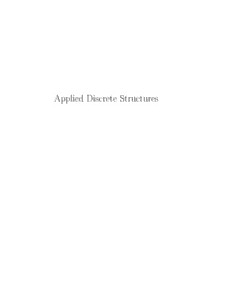Table Of ContentApplied Discrete Structures
Applied Discrete Structures
Al Doerr
University of Massachusetts Lowell
Ken Levasseur
University of Massachusetts Lowell
September, 2016
© 2016 Al Doerr, Ken Levasseur
Applied Discrete Structures by Alan Doerr and Kenneth Levasseur is licensed un-
deraCreativeCommonsAttribution-NonCommercial-ShareAlike3.0UnitedStates
License. You are free to Share: copy and redistribute the material in any medium
orformat; Adapt: remix,transform,andbuilduponthematerial. Youmaynotuse
the material for commercial purposes. The licensor cannot revoke these freedoms
as long as you follow the license terms.
To our families
Donna, Christopher, Melissa, and Patrick Doerr
Karen, Joseph, Kathryn, and Matthew Levasseur
Acknowledgements
List 0.0.1 (Instructor Contributions). We would like to acknowledge the following
instructors for their helpful comments and suggestions.
• Tibor Beke, UMass Lowell • Sitansu Mittra, UMass Lowell
• Alex DeCourcy, UMass Lowell • Ravi Montenegro, UMass Lowell
• Vince DiChiacchio • Tony Penta, UMass Lowell
• Dan Klain, UMass Lowell • Jim Propp, UMass Lowell
I’d like to particularly single out Jim Propp for his close scrutiny, along with
that of his students, who are listed below.
List 0.0.2 (Student Contributions). Many students have provided feedback and
pointed out typos in several editions of this book. They are listed below. Students
with no affiliation listed are from UMass Lowell.
• Anju Balaji • Michael Ingemi • Paola Pevzner
• Chris Berns • William Jozefczyk • Samantha Poirier
• Raymond Berger, • Leant Seu Kim • Ian Roberts
Eckerd College
• John Kuczynski • Chita Sano
• Sam Bouchard
• Kendra Lansing • Mason Sirois
• Rebecca Campbell
• Ariel Leva
• Sam Chambers • Doug Salvati
• Andrew Magee
• Alex DeCourcy • Anh Vo
• Ryan Delosh • Nick McArdle • Several students at
Luzurne County
• Anthony Gaeta • Mike Morley
Community College
• Holly Goodreau • Hung Nguyen (PA)
I would like to thank Rob Beezer, David Farmer and other participants on
the mathbook-xml-support group for their guidance and work on MathBook XML.
Thanks to the Pedagogy Subcommittee of the UMass Lowell Transformational Ed-
ucation Committee for their financial assistance in helping getting this project
started.
vii
viii
Preface
This version of Applied Discrete Structures is being developed using Mathbook
XML, A lightweight XML application for authors of scientific articles, textbooks
and monographs initiated by Rob Beezer, U. of Puget Sound.
We embarked on this open-source project in 2010. The choice of Mathematica
for "source code" was based on the speed with which we could do the conversion.
However,theformatwasnotideal,withnoviablewebversionavailable. Theproject
hasbeen well-received inspiteof theseissues. Validation throughthelistingofthis
projectontheAmericanInstituteofMathematicshasbeenveryhelpful. Whenthe
MBX project was launched, it was the natural next step. The features of MBX
make it far more readable than our first versions, with web, pdf and print copies
being far more readable.
Twenty-one years after the publication of the 2nd edition of Applied Discrete
Structures for Computer Science, in 1989 the publishing and computing landscape
had both changed dramatically. We signed a contract for the second edition with
Science Research Associates in 1988 but by the time the book was ready to print,
SRAhadbeensoldtoMacMillan. Soonafter,therightshadbeenpassedontoPear-
sonEducation,Inc. In2010,thelong-termfutureofprintedtextbooksisuncertain.
In the meantime, textbook prices (both printed and e-books) have increased and a
growingopensourcetextbookmarketmovementhasstarted. Oneofourobjectives
inrevisitingthistextistomakeitavailabletoourstudentsinanaffordableformat.
In its original form, the text was peer-reviewed and was adopted for use at sev-
eral universities throughout the country. For this reason, we see Applied Discrete
Structures as not only an inexpensive alternative, but a high quality alternative.
As indicated above the computing landscape is very different from the 1980’s
andaccountsforthemostsignificantchangesinthetext. Oneofthemostcommon
programming languages of the 1980’s, Pascal; and we used it to illustrate many
of the concepts in the text. Although it isn’t totally dead, Pascal is far from the
mainstream of computing in the 21st century. In 1989, Mathematica had been out
for less than a year — now a major force in scientific computing. The open source
software movement also started in the 1980’s and in 2005, the first version of Sage,
an open-source alternative to Mathematica was first released. In Applied Discrete
Structures we have replaced "Pascal Notes" with "Mathematica Notes" and "Sage
Notes." Finally, 1989 was the year that World Wide Web was invented by Tim
Berners-Lee. There wasn’t a single www in the 2nd edition.
Sage (sagemath.org) is a free, open source, software system for advanced math-
ematics. Sage can be used either on your own computer, a local server, or on
SageMathCloud (https://cloud.sagemath.com).
Ken Levasseur
Lowell MA
ix
x

